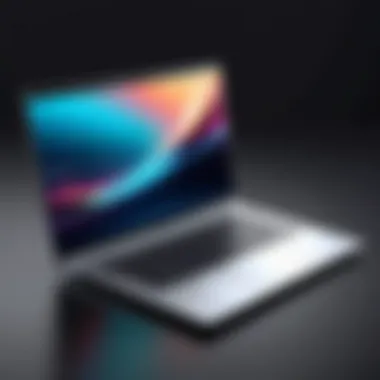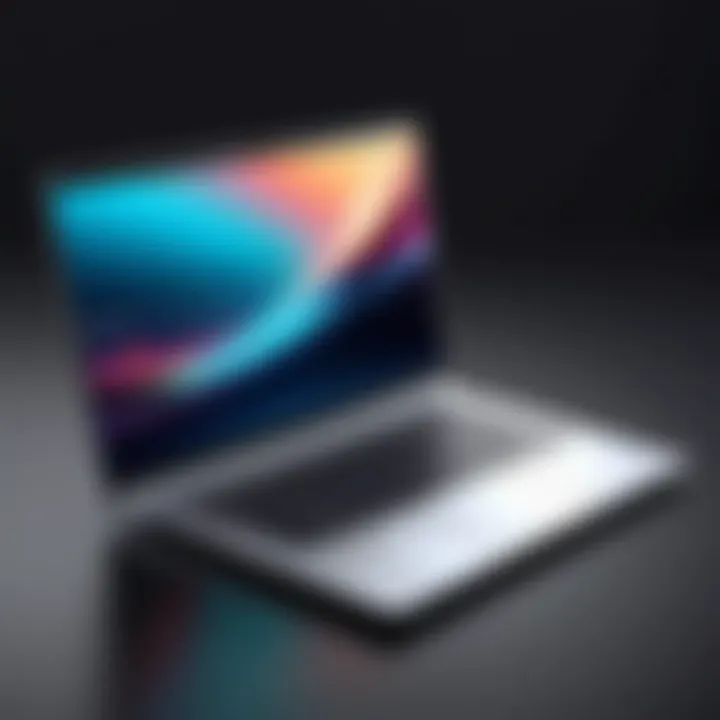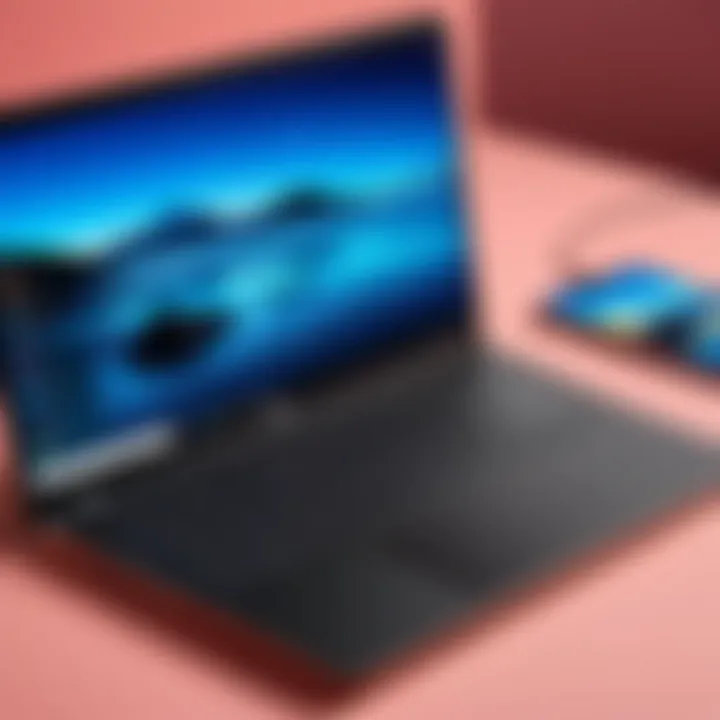Choosing the Right Laptop for Teenagers: A Guide


Intro
Selecting a laptop for teenagers is a unique challenge that combines technical considerations with personal preferences. Understanding the needs of today’s youth necessitates a careful approach, as the right device can enhance both academic performance and recreational engagement. Key aspects such as performance requirements, design preferences, budget constraints, and intended uses will play a significant role in the decision-making process. This article aims to dissect these factors, helping parents and teenagers alike to make informed choices that align with both objectives and aspirations.
The relevance of this topic rises from the increasing role technology plays in education and social interaction. A laptop is not just a tool for school anymore; it serves as a platform for creativity, communication, and leisure. Hence, being well-informed about various options is essential to finding a laptop that balances performance and functionality while appealing to a teenager’s taste.
Additionally, we will reflect upon potential academic applications, such as online learning and assignment completion, alongside recreational uses like gaming, streaming, and creative projects. Insights from these domains will reflect the real-world implications of choosing an appropriate laptop. Readers should expect to take away a comprehensive overview that encapsulates the multifaceted nature of selecting a laptop for the younger generation.
Understanding Teenager's Needs
Selecting a laptop for teenagers requires a thorough understanding of their unique requirements. This demographic presents specific needs shaped by both academic obligations and diverse recreational interests. Grasping these needs is crucial for parents and guardians to make informed choices when investing in a laptop.
Teenagers typically engage with technology differently than adults. Thus, comprehending their demands can lead to better utilization of the device. By prioritizing academic use, gaming, or creative endeavors, we can align the decision-making process with the teenager's lifestyle. Addressing these key areas ensures that the selected laptop serves its intended purpose efficiently, while also providing adequate performance for various activities.
Identifying Purpose
Understanding the specific purposes for which teenagers will utilize a laptop can significantly influence the selection process. Here, we delve into three primary uses that are prevalent among teens today: academic use, gaming, and content creation.
Academic Use
In academics, a laptop serves not just as a tool for writing essays, but as a platform for research, presentations, and online learning. The key characteristic of academic use is functionality. Laptops designed for academic tasks often prioritize lightweight designs and long battery life. A laptop that can easily handle word processing applications, web browsing, and video calls is essential for students navigating their study schedules.
The unique feature of these laptops is their emphasis on multi-tasking capabilities. It is crucial that they can run multiple applications simultaneously without lagging. A strong processor and sufficient RAM are vital for this purpose. However, the downside can be the limited graphics capabilities, which may not support high-demand applications such as gaming or graphic design.
Gaming
For many teenagers, gaming is a significant factor when choosing a laptop. The popularity of online and offline games creates a demand for systems that can handle resource-intensive graphics and processing. The critical aspect here is performance. A gaming laptop typically features advanced graphics capabilities, a robust processor, and increased RAM. These specs allow for smoother gameplay and rich visuals.
One distinct feature of gaming laptops is their frequently enhanced cooling systems. This addresses the heat generated during extended gaming sessions. However, they can be pricier than standard laptops, which may not suit everyone's budget.
Content Creation
Content creation includes activities like video editing, graphic design, and music production. Teens interested in developing such skills often require laptops with high processing power and superior graphics capabilities. The major characteristic of content creation laptops is versatility. They must efficiently support demanding software applications like Adobe Creative Suite or similar programs.
The unique advantage of investing in a laptop for content creation is its potential to boost creativity through powerful tools. An essential element in these devices is high-resolution displays, which contribute significantly to the overall user experience. However, these laptops may also come with a higher price tag, which could be a downside for budget-conscious consumers.
Assessing Skill Level
Another vital factor to consider when selecting a laptop for teenagers is their skill level. This influences the type of laptop that would best serve their needs. Teenagers generally fall into three categories: basic users, intermediate users, and advanced users.
Basic Users
Basic users typically require laptops solely for everyday tasks such as browsing the internet, watching videos, or using basic productivity applications. These individuals focus on practicality rather than performance. The key characteristic here is simplicity. Laptops for basic users are generally low-cost and offer straightforward functionalities without complex features.
A significant advantage is that these laptops are often lightweight and portable, making them easy to carry. However, they may lack the power needed for more demanding applications, limiting their usability as the teenager's needs evolve.
Intermediate Users
Intermediate users are those who engage in a blend of activities. This might include light gaming, multimedia consumption, and moderate content creation. These users value performance along with some versatility. The key characteristic of their laptops is a balance between price and capability.
A unique feature here is the availability of devices that can easily run mid-level software while still keeping costs manageable. However, the disadvantage could be that these laptops may not perform well under heavy loads, which can be restrictive.
Advanced Users
Advanced users involve teenagers who are heavily engaged in high-performance computing. They might be gamers, programmers, or graphic designers needing substantial resources to run demanding applications. Their key characteristic is performance over cost. High-end laptops for these users are well-equipped with fast processors and enhanced graphics.
Performance Specifications
Performance specifications play a critical role in selecting a laptop for teenagers. At this stage, the focus is on the components that will determine how well the laptop performs under various scenarios, be it academic tasks, gaming, or content creation. Understanding processor types, RAM requirements, and storage options is crucial for making an informed decision.
Processor Types
Intel vs. AMD
Intel and AMD dominate the laptop processor market. Intel is often favored for its well-established reputation for stability and performance. The Core line, in particular, has been a popular choice for many users. AMD, on the other hand, has made significant strides in offering competition with its Ryzen processors. AMD generally offers better multi-threaded performance, which is advantageous for tasks like video editing or gaming.
Both brands have their unique features. Intel CPUs tend to provide superior power efficiency while AMD processors often come with more cores at competitive prices. Each option has benefits depending on the specific needs of the user, such as gaming or multitasking.
Core i3/i5/i7 Considerations
The Core i3, i5, and i7 options represent different tiers in Intel's lineup. The Core i3 is suitable for basic tasks like web browsing and document editing. The Core i5 is a balanced choice, often preferred for both light gaming and productivity work. The Core i7 excels at resource-intensive applications due to its higher clock speeds and more cores.
Choosing between these options depends on the intended usage. If a teenager needs a laptop for academic use and occasional gaming, a Core i5 may serve them well. For those focused on high-end gaming or creative work, investing in a Core i7 could be worth it.
Processor Generations
Each new generation of processors typically comes with improvements in speed, power efficiency, and new features. Intel, for example, has consistently released newer generations that enhance not just performance but also thermal management.
These updates can significantly impact a laptop's lifespan. Opting for a newer generation processor usually means improved longevity and better performance for future software demands. Therefore, buyers should be aware of processor generations to avoid outdated technology.
RAM Requirements
8GB vs. 16GB
RAM is paramount for multitasking and overall performance. Most laptops come with either 8GB or 16GB of RAM. 8GB is sufficient for basic tasks like word processing, browsing, and light gaming. However, for gamers or users running demanding applications, 16GB provides a noticeable advantage.
The choice should be guided by expected use cases. As software becomes more demanding, opting for 16GB might future-proof the investment.
Future-Proofing
Future-proofing focuses on selecting a device that will meet demands in the coming years. With the rapid evolution of software and increase in multitasking needs, future-proofing often means choosing higher performance components upfront.
As teenagers progress in their studies or interests, their laptop needs may shift. This might include engaging in graphic design or gaming. Selecting high specifications now can avoid costly upgrades later.
Multitasking Capabilities
Multitasking capabilities largely depend on how a laptop can handle concurrent operations. A laptop with sufficient RAM allows smoother operation when switching between applications. This is essential for teenagers using many tools at once for studying and entertainment.
A laptop with solid multitasking capabilities ensures that performance does not lag when handling various tasks, supporting both gaming and productivity.
Storage Options
SSD vs. HDD
When choosing between SSDs and HDDs, consider access speed and overall performance. SSDs provide faster loading times and overall performance, while HDDs offer larger storage capacity at lower prices. This makes SSDs a favorable option for both gamers and content creators who require swift responsiveness.
The immediate access speeds of an SSD can significantly enhance the user experience, reducing frustration and increasing productivity.
Storage Capacity
Storage capacity varies widely. For casual use, 256GB may suffice, but gamers or those handling large files should consider options of 512GB or higher. Balancing storage space with budget constraints is vital. It is wise to evaluate how much storage is needed for applications, media, and game installations.
Cloud Storage Alternatives
As cloud storage options become increasingly viable, many users are turning to services like Google Drive or Dropbox. These alternatives allow you to free up local space while maintaining accessibility to files from various devices. The challenge is to ensure reliable internet access to make the most out of cloud storage.


Leveraging cloud solutions in tandem with internal storage can create a practical setup that meets intensive needs without overwhelming budget limitations.
"Balanced performance can make a significant difference in how well a laptop meets a teenager's diverse needs."
Display Considerations
Choosing the right display is critical when picking a laptop for teenagers. The screen serves as the primary interface for interaction and can greatly affect the overall user experience. Key aspects to evaluate include screen size, resolution, and display technology. Each factor plays a significant role in usability, performance, and enjoyment, particularly for tasks that require significant visual input like gaming, video editing, or browsing content.
Screen Size
Portability vs. Usability
When selecting a screen size, the trade-off between portability and usability is vital. Smaller screens, typically around 13 inches, are lightweight and easy to carry, making them practical for students who commute. However, they may compromise usability, especially for tasks requiring significant screen real estate like coding or graphic design.
Conversely, larger screens of 15 inches or more enhance usability. They offer more display space, making multitasking easier. Yet, they can be cumbersome for on-the-go students. Balancing portability with usability creates a better laptop experience tailored to a teenager’s needs.
Common Sizes
Common laptop sizes include 13-inch, 15-inch, and 17-inch displays. Each size serves different user preferences. The 13-inch laptop is ideal for students focused on note-taking and light browsing. A 15-inch laptop strikes a good balance, accommodating general use and some gaming. The 17-inch option is popular among gamers and content creators, as it provides ample screen space for applications but sacrifices some portability.
Being aware of these common sizes allows buyers to select an option that best fits their teenager's lifestyle and usage requirements, ensuring optimal satisfaction with their device.
Impact on Gaming
Screen size also directly influences gaming experiences. Larger displays enhance immersion due to bigger visuals. Gamers often prefer 15-inch or 17-inch laptops, which enable better visibility during gameplay. Additionally, larger screens minimize eye strain during extended gaming sessions.
However, gamers should also consider resolution with larger screens, as low-resolution graphics can lead to a pixelated gaming experience. Therefore, the selection of the right screen size and resolution should reflect both gaming interests and other laptop uses.
Resolution Choices
1080p vs. 4K
Resolution plays an important role in display quality. A 1080p (Full HD) resolution provides a solid experience for most tasks, including gaming and streaming. It balances good image quality with lower system requirements, theoretically extending battery life on mid-range laptops.
In contrast, 4K displays deliver stunning visuals. They are perfect for content creation and graphic design, as they showcase more detail. However, 4K significantly demands more from both the battery and the hardware. This is critical for users focused on long-term performance. Balancing resolution with functionality is essential in decision-making.
Impact on Battery Life
Higher resolution screens generally consume more power. A laptop with 4K display may deliver great visuals but negatively affects battery life. Teenagers who intend to use their laptops on the go must weigh battery longevity against display quality.
Opting for a 1080p screen might be advantageous for those who value battery efficiency. The right resolution can enhance user experience without pushing hardware and battery capabilities too far.
Content Viewing Experience
Resolution greatly affects content viewing experiences. Higher resolutions provide sharper images, enhancing movies and gaming. For content creators, the ability to see finer details is crucial when producing videos or graphics.
Yet, not all content is available in 4K, making it somewhat redundant for standard use or streaming. Therefore, understanding content consumption patterns will help in selecting the best resolution for individual needs.
Display Technologies
IPS vs. TN Panels
The type of panel technology impacts image quality and viewing angles. IPS (In-Plane Switching) panels are known for their vibrant colors and wider viewing angles. These qualities make IPS panels an excellent choice for gaming and design tasks where color fidelity is crucial.
On the other hand, TN (Twisted Nematic) panels typically feature faster response times. They are often less expensive, but they suffer from poorer color reproduction and limited viewing angles. Understanding these differences can guide buyers toward the best panel type for their intended laptop uses.
Touchscreens
Touchscreen laptops offer a unique interface that adds another dimension to usability. They allow for intuitive navigation and are beneficial for creative tasks, such as drawing or design.
The downside is that touchscreens can drive up the price of laptops and may also contribute to reduced battery life. Therefore, teenagers should evaluate whether a touchscreen benefits their daily usage or if it serves as an unnecessary luxury.
Anti-Glare Features
Anti-glare screens help reduce reflections from ambient light. This feature is especially useful for teenagers who study or work in varying environments. It can lead to a more comfortable viewing experience, reducing eye strain.
However, it may result in less vibrant colors than glossy displays. Teenagers need to consider their primary usage environments. A non-reflective screen often enhances visibility and usability in bright settings, making it a practical choice for students.
Overall, understanding these display considerations is crucial for selecting a laptop that meets the diverse needs of teenagers, ensuring they have a device that is well-suited for their academic and personal pursuits.
Build Quality and Design
In the contemporary landscape of technology, where laptops serve as essential tools for education, recreation, and social interaction, build quality and design become paramount considerations. A well-constructed laptop not only enhances user experience but also contributes to the longevity of the device. For teenagers, who often use laptops in various environments, from classrooms to cafes, durability and style must go hand in hand. It's crucial to choose a laptop that is both robust and visually appealing to meet their preferences and practical needs.
Materials Used
Plastic vs. Metal
The materials chosen in laptop construction can significantly affect their overall quality and user perception. Plastic models are generally lighter, which makes them easy to carry. They are often more affordable, catering well to budget-conscious families. However, they may lack the premium feel and durability of metal laptops. On the other hand, metal laptops, such as those made from aluminum or magnesium alloy, offer superior sturdiness. They can resist wear and tear better, making them a wise investment for active teenagers. This increased durability is crucial since many youths may not handle their devices with utmost care.
Durability Factors
When evaluating durability, consider how materials withstand daily use. Stronger materials resist bending, flexing, or even damage from drops. A key characteristic of durability is the manufacturer's focus on reinforcement in areas prone to stress, such as hinges and corners. A laptop with good durability is essential for adolescents who might drop their devices or expose them to various environments. This factor can significantly affect the overall decision, making it important to research manufacturers’ reputations for quality.
Weight Considerations
Weight plays a significant role in the usability of a laptop, especially for teenagers who may need to transport it between classes or other locations. A lighter laptop can lead to greater comfort during transport. However, it should still provide the right balance between comfort and capability. A laptop that is too light might compromise on features or performance, which in turn affects usability. Thus, weighing the benefits of portability against desired functionalities is essential when selecting the appropriate laptop.
Keyboard and Touchpad
Ergonomics
Ergonomics in laptop design involves the comfort and ease of use of the keyboard and touchpad. A well-designed ergonomic keyboard reduces strain during prolonged typing sessions, which benefits students. Keyboards that are positioned appropriately can prevent wrist discomfort, allowing for a healthier typing posture. This aspect is particularly significant since teenagers are likely to engage in extended periods of academic work.
Key Travel
Key travel refers to the distance a key moves when pressed. A satisfactory key travel distance can enhance typing experience, facilitating smoother and more accurate input. Models with insufficient key travel may not provide the necessary tactile feedback, resulting in typing errors and frustration. Therefore, prioritize laptops that offer a balanced key travel, contributing to efficiency and user satisfaction.
Multi-Touch Support
Multi-touch support on the touchpad can enhance user interactions, allowing for gestures like pinch-to-zoom and swipe actions. This feature can make navigation more intuitive, especially for younger users who are accustomed to such functionalities on tablets and smartphones. Considering how this integration improves usability is essential for teenagers who appreciate modern interactions with their devices.
Aesthetic Appeal
Color Options
Color options can play a significant role in a teenager's relationship with their laptop. Many younger users prefer laptops that reflect their personality or that are visually appealing. A wider selection of color choices can influence their decision, as they might want to differentiate their device from others. Laptops that are available in various bold and subtle shades can attract teens looking for a balance of style and functionality.
Branding
Branding influences perceptions and choices significantly. Well-known brands often carry reputations for quality and reliability, which can reassure buyers. Each brand tends to have unique designs and features that target different demographics, including teenagers. Understanding why a specific brand resonates with younger users can help in making an informed choice.
Customization Options
Customization options allow teenagers to personalize their laptops to some extent. Whether it's through interchangeable skins, stickers, or different software setups, such choices can enhance the ownership experience. The ability to customize can influence individual expression, making the laptop feel more personal and valued. Hence, laptops that offer various customization avenues are often favorable among this audience.
Battery Life Expectations


When selecting a laptop, battery life is an indispensable consideration, especially for teenagers who often balance academic responsibilities, gaming, and social activities. A laptop that promises sufficient battery life can enhance user experience significantly. Especially, if you want a laptop for usage without the constant need to plug in during the day, exploring battery life expectations becomes vital. A well-performing battery supports learning, productivity, and entertainment wherever teenagers may find themselves.
Typical Usage Expectations
General Use
General use refers to the everyday tasks teenagers might perform on their laptops, such as browsing the web, writing essays, or completing assignments. The key characteristic of general use is versatility; these laptops can manage multiple tasks effectively. They consume moderate power, allowing for extended usage throughout the day.
One unique feature of laptops designed for general use is their ability to balance performance and energy consumption. This dual capability can be beneficial because it enables students to use their laptops for hours without being tethered to a power outlet. However, it is crucial to note that screen brightness and battery-draining applications can significantly impact battery life.
Gaming
Gaming is another popular use case that can significantly affect battery performance. Laptops designed for gaming typically come equipped with powerful processors and graphics cards, which demand more power, leading to shorter battery life. The important aspect of gaming laptops is that while they can handle demanding games, they might require frequent charging.
A unique feature of gaming laptops is their high refresh rates and advanced graphics capabilities. These features provide enhanced gaming experiences. Still, they can also lead to rapid battery drain when playing graphics-intensive games. Gamers must be aware that running demanding applications can limit the time they can use their laptops away from a power source.
Streaming Content
Streaming content involves watching videos or playing multimedia on laptops. The vital characteristic of laptops used for this purpose is display quality and sound capabilities. Such laptops can handle high-definition content well, providing a rich viewing experience.
One unique aspect of streaming laptops is their ability to optimize battery usage based on content. For example, streaming at a lower resolution can prolong battery life. However, engaging in prolonged streaming can still drain batteries relatively quickly. Thus, teenagers looking to use laptops for streaming should consider models that offer good battery life while watching shows or movies.
Measuring Battery Life
Manufacturer Claims
Device manufacturers often list battery life expectations on their specifications. These claims can provide an initial idea of what to expect. The critical point is that manufacturer claims may not always match real-life performance. They often test under ideal conditions, which might not reflect day-to-day conditions.
The main advantage of relying on manufacturer claims is that they provide a benchmark for comparison against various models. However, relying solely on these numbers can be misleading, as different usage patterns can drastically affect battery performance.
Real-World Use Tests
Real-world use tests involve assessing how long the battery truly lasts during everyday activities. Reviews and testimonials often discuss how laptops perform in real conditions. This testing is essential because it gives insights into battery longevity during actual usage.
The significant benefit of these tests is that they help set realistic expectations. By understanding how long a laptop lasts under typical usage, consumers can make more informed choices. However, these tests can vary based on different factors, such as screen brightness or running background applications, so the results may not be entirely uniform.
Battery Conditioning
Battery conditioning is the process of optimizing battery performance over time. It involves fully charging and discharging the battery to maintain its health. The key aspect of battery conditioning is its impact on overall battery lifespan and efficiency.
One notable advantage of battery conditioning is that it can help users extend their battery life over time. For instance, by properly maintaining the battery through conditioning practices, teenagers can ensure better performance during their laptop’s operational life. However, improper charging habits can lead to shorter battery life, complicating the user experience.
A well-selected laptop battery can enhance productivity and leisure activities, making it essential to evaluate these aspects in depth.
Port Selection and Connectivity
Port selection and connectivity are vital aspects when choosing a laptop for teenagers. As their activities range from academic work to gaming and content creation, the right ports can enhance their overall experience. Connecting various devices is key to efficiency and versatility. It is important to consider how many and which types of ports a laptop has to ensure it meets all needs. A solid selection of ports can also extend the laptop's functionality.
Essential Ports
USB Types
USB ports are essential for connecting a wide range of devices. They allow users to connect peripherals like mice, keyboards, or external drives. There are several types of USB ports, including USB-A, USB-C, and USB 3.0. A key characteristic of USB-C is its reversible design, making it easy to plug in. Moreover, USB-C supports faster data transfer speeds and can charge devices, a distinctive feature that offers convenience.
The versatility of USB types makes them a popular choice among teenagers. They can work well with both older and newer devices. However, not all laptops may have all types of USB ports, which can limit connectivity options for some users.
HDMI
HDMI ports are crucial for connecting laptops to external displays or televisions. This is particularly useful for gaming or streaming movies, as it allows the output of high-definition video and audio quality. The high bandwidth of HDMI supports modern high-resolution formats. This makes it a beneficial feature for those who enjoy gaming or content creation.
One unique aspect of HDMI is its widespread use across multiple devices, making it a common standard. However, some laptops may not include an HDMI port, instead opting for other types of connections, which could frustrate users who depend on this feature.
Audio Jacks
Audio jacks provide an essential connection point for headphones or speakers. Many teenagers enjoy listening to music, playing games, or engaging with multimedia content. A standard 3.5mm audio jack is usually found on most laptops, making it easy to connect various audio devices. The characteristic durability and simplicity of audio jacks make them a popular choice.
One disadvantage could be that some newer laptops are moving away from traditional audio jacks to allow for thinner designs. This can restrict user choices if they prefer wired audio devices, requiring them to rely on adapters or wireless solutions instead.
Wireless Connectivity
Wi-Fi Standards
Wi-Fi standards are an integral part of any modern laptop. These standards determine the speed and range of wireless connections. The current standard, Wi-Fi 6, offers improved performance and efficiency. It can handle more devices at once, which is beneficial for households where multiple family members may be online simultaneously.
A significant advantage of updated Wi-Fi standards is the improved connection stability and speed when streaming or gaming. However, not all laptops support the latest standards, potentially limiting the effectiveness of home networks.
Bluetooth Capabilities
Bluetooth technology allows for short-range wireless communication with accessories. Headphones, keyboards, and mice often connect via Bluetooth, making it a convenient option for users. The latest Bluetooth versions provide enhanced range and lower energy consumption.
This capability is beneficial as it minimizes cable clutter, offering a cleaner setup. The downside of Bluetooth is that older devices may not support the latest features, leading to connectivity issues for some accessories.
Future-Proofing
Future-proofing is an important consideration for any laptop purchase. This involves selecting a laptop that can adapt to evolving technology. For instance, choosing a laptop with multiple USB-C ports or support for the latest Wi-Fi standards ensures longevity in an ever-changing tech landscape.
Key characteristics of future-proofing include versatile connectivity options and hardware that can handle anticipated software updates. A laptop with these features may require a higher initial investment, but it will likely provide better value in the long run.
"Selecting the right ports and ensuring proper connectivity can dramatically influence a teenager's laptop experience."
Budget Considerations
Making a decision about a laptop purchase requires understanding the financial implications. For teenagers, budget considerations play a crucial role in guiding both parents and students. It is crucial to ensure that the investment aligns with their needs and usage patterns without overspending. Exploring the financial landscape includes assessing affordability and ensuring value in what is purchased.
Setting a Budget
Assessing Financial Constraints
When assessing financial constraints, it is essential to establish a clear idea of what can be spent. This process helps to narrow down options effectively. The key characteristic of financial constraints is the limit placed on spending based on available funds. This is beneficial in this article as it helps focus on practical choices without veering into unnecessary expenses.
A unique feature in assessing financial constraints is its role in setting realistic expectations. Knowing what is feasible ensures that one can evaluate potential laptops without disappointment. The advantage here is avoiding getting drawn to features that exceed the budget. However, the disadvantage may come from feeling restricted by a tight budget.
Value for Money
Value for money serves as a guiding principle in laptop selection. The focus here is on balancing performance with cost. The key characteristic of value for money lies in obtaining laptops that offer the best features for the price. This makes it a popular choice in this article, as parents want to ensure the best return on their investment.
A unique aspect of value for money is the emphasis on durability and performance over flashy features. This ensures that the laptop not only meets current needs but also holds up over time. The advantage is that it encourages sound decision-making, but there might be confusion when distinguishing between quality and marketing hype.
Long-term Investment
Looking at laptops as long-term investments changes the buying perspective. This idea shifts focus towards future-proofing against evolving needs. The key characteristic of a long-term investment is understanding that electronics depreciate but can still provide value years after purchase. This is beneficial as it encourages thoughtful purchases instead of quick buys.
A unique feature of treating a laptop as a long-term investment is the focus on upgradeability and support. Buyers may consider machines that allow for parts upgrades, extending their usable life. The advantage lies in staying relevant with technology changes. However, the downside can include higher initial costs, which may be challenging for some budgets.
Best Budget Laptops


Exploring options for budget laptops is essential in this article. The choices must cover various price ranges and performance needs, ensuring that different requirements can be met without sacrificing quality or usability.
Under $500
Options for laptops under $500 provide entry-level choices suitable for basic use. This price point is attractive because it offers a balance between affordability and essential features. Users can find devices capable of handling simple tasks like browsing and document editing.
A major characteristic of this price range is the availability of solid brands that deliver dependable performance. An example could include the Acer Aspire series which provides an excellent mix of specs without breaking the bank. However, potential drawbacks include limited processing power and lesser build quality compared to pricier models.
Mid-Range Options
Mid-range options typically fall between $500 and $1000, attracting those who need more power without the premium price tag. These laptops often feature higher performance specifications. This range stands out for its ability to provide enhanced performance for both academic and leisure activities, such as gaming or content creation.
A characteristic of mid-range laptops is the diverse selection available, like the Dell Inspiron series, which meets a variety of needs effectively. The unique feature here involves better battery life and improved screen quality. Nevertheless, some configurations might still feel limiting compared to higher-end models, particularly for serious gaming or intensive editing tasks.
Premium Choices
Premium choices represent the upper tier, priced above $1000. This selection is designed for users requiring high performance, such as gamers or design students. The characteristic of this segment is cutting-edge technology that offers advanced features like high refresh rates and superior graphics.
Devices like the MacBook Pro and Razer Blade exemplify premium choices in the market. Their strong build quality, excellent display, and long-lasting performance make them appealing. The unique aspect is the blend of aesthetic design with functionality. However, the downside is the significant price, which may not align with every budget but is often justified by the performance and longevity of the devices.
Researching Brands
When exploring laptops for teenagers, it is vital to consider the brands that produce them. The right brand can affect the quality, performance, and longevity of the laptop. An understanding of well-recognized brands helps in making informed choices. Researching brands allows buyers to analyze their reputation, offerings, and support systems, which all contribute to the overall user experience. Each brand offers unique characteristics, targeting different aspects such as performance, aesthetics, or affordability. Thus, knowledge of these brands plays a significant role in ensuring the satisfaction of the final buyer.
Popular Laptop Brands
Dell
Dell is a well-established name in the computer market. The brand is known for its reliable performance and appealing designs. One key characteristic of Dell laptops is their extensive range, which caters to various needs from basic browsing to high-end gaming. Dell laptops, such as the Dell XPS series, provide excellent display quality and robust build that many find beneficial for both academic and personal use. However, some models may come at a higher price point compared to competitors, which can be a disadvantage for budget-conscious buyers.
HP
HP, or Hewlett-Packard, stands out for its commitment to innovation and user satisfaction. They offer a wide selection of laptops with features tailored for teenagers, such as the HP Pavilion series that balances performance and price effectively. A unique feature of HP laptops is their fast recharge capability, allowing users to power up quickly, which is essential for students with tight schedules. On the downside, some HP laptops may experience issues with customer service, leading to mixed reviews among users.
Apple
Apple laptops, mainly the MacBook line, are known for their premium design and ecosystem integration. Their strong focus on user experience makes the MacBook a favorite among creative teenagers who need reliable performance for graphic design or video editing. The unique aspect of Apple laptops is their operating system, macOS, which many users find intuitive and user-friendly. That said, the higher price tag and limited upgrade options can be significant drawbacks for some consumers.
Lenovo
Lenovo is recognized for producing versatile laptops, notably the ThinkPad series, which is popular for students who require durability and performance. The strong build quality and excellent keyboard make Lenovo laptops appealing for those high volume typing tasks. An advantage of Lenovo is the range of choices, from affordable models to high-performance devices. However, some users critique the design aesthetics, saying they lack the modern touch present in other brands.
Brand Reputation
Customer Support
Effective customer support plays a crucial role in brand reputation. Reliable customer service ensures that help is available when needed. This is especially important for teenagers who may need assistance with troubleshooting or technical issues. Brands with responsive support, like Dell and Lenovo, often gain positive feedback. On the other hand, inadequate support from brands can lead to frustration and unresolved problems.
Warranty Options
Analyzing warranty options is essential when considering a laptop purchase. A strong warranty can reflect a brand’s confidence in its products. Brands offering extended warranties demonstrate their commitment to quality and customer satisfaction. This can be important for parents looking to protect their investment in a teenager’s laptop. Conversely, limited warranty options might deter buyers who want assurance about the durability of their purchase.
Consumer Reviews
Consumer reviews provide insights into the real-world performance of laptops. Prospective buyers should consider these reviews as they reveal common problems and advantages experienced by users. Brands like HP and Apple often receive attention in forums for their differing user experiences. Reviews can help parents and teenagers discern between choices that are purely marketing-driven and those that fulfill actual user needs.
Considering Future Needs
When selecting a laptop for teenagers, one important aspect cannot be overlooked: considering future needs. Teens often have evolving requirements, whether for academics or personal use. Technology grows rapidly, and students must also adapt to this change. Thus, understanding future requirements is crucial for making a wise investment.
One fundamental benefit of planning for the future is ensuring that the laptop remains relevant as software demands increase. Laptops that may suffice today might quickly become obsolete. This planning helps prolong the laptop's useful life, promoting better value.
Gaming Requirements
Upcoming Game Demands
The gaming industry continually advances, with each new release demanding greater processing power and graphics capabilities. This factor makes Gaming Requirements a critical consideration for selecting a laptop. The unique feature about these upcoming game demands is that they often outpace the capabilities of existing models. As a result, understanding these demands is beneficial to ensure the laptop can handle new titles.
For example, games like "Cyberpunk 2077" or "Elden Ring" require significant RAM and powerful graphics chips. The trend towards higher-quality graphics and more complex game environments means a long-term investment in higher specifications today will pay off in the future. Not contemplating these needs can result in disappointing gaming experiences.
Hardware Longevity
Hardware Longevity refers to the potential lifespan of a laptop based on its specifications. Selecting hardware that can withstand technological evolution is vital. A key characteristic of durable laptops is their ability to support upgrades and handle new software without performance drops. A laptop offering longevity allows teenagers to leverage their devices for many years instead of needing a premature replacement.
In particular, options like replaceable RAM or storage can enhance longevity. This is advantageous, especially when funds for a new device are limited. However, in some cases, such hardware longevity may not be supported by cheaper budget models, which can limit the device's life.
Upgrade Possibilities
Upgrade Possibilities play a significant role in how well a laptop serves the user over time. A laptop that permits upgrades, such as boosting RAM or changing the hard drive, allows the user to adapt to new requirements without facing the need to buy a different machine.
A notable advantage of this feature is the cost-effectiveness it offers. While an initial investment might seem higher for a laptop that supports upgrades, the savings from avoiding an entire replacement can be substantial.
Evolving Academic Tools
Software Changes
Adapting to Software Changes is essential as educational tools continue to evolve. As schools and universities embrace more sophisticated software tools for learning, it is necessary for laptops to keep pace. Understanding how these changes can affect academic success is vital for ensuring students have appropriate tools.
A key insight here is that software used for academic purposes often requires more robust system specifications. This shift toward more advanced software can influence performance and compatibility. For teens, having a laptop that can manage these changes is critical.
Emerging Technologies
Emerging Technologies represent the ongoing advancements in tools and platforms used in educational settings. Different educational institutions increasingly integrate mixed reality, artificial intelligence, and collaborative tools into their curricula. Selecting a laptop that can leverage emerging technologies will empower teens to enhance their learning.
One of the main advantages of emerging technologies in academia is that they promote interactive learning experiences. However, not every laptop is designed to support such technologies, and without the proper specifications, students may miss out on valuable opportunities to improve their skills.
Adaptation Strategies
Adaptation Strategies are fundamental when considering how to meet the demands of changing academic environments. Teens must be prepared to adjust to new tools, platforms, and forms of collaboration that their educational institutions may adopt over time.
A crucial characteristic of a well-chosen laptop is its ability to evolve along with emerging technologies. This flexibility can enhance learning and engagement. However, without an appropriate device, teenagers may struggle to keep up with their peers who have better-suited technology.
In summary, considering future needs not only aids in making a wiser financial choice but also ensures that teenagers possess the tools they need to excel in both academics and gaming.
Understanding these elements provides clarity in selecting the appropriate device for the long run.
The End
In selecting a laptop for teenagers, the conclusion serves as a crucial checkpoint. This is where one synthesizes all the information discussed and assesses its significance. The importance of understanding the unique needs of teenagers is fundamental. Not only does it shape their academic performance, but it also influences their leisure activities. Each factor, from processor power to design, contributes to how well the laptop supports those needs.
Final Thoughts
Summary of Key Points
The summary of key points provides clarity on what has been covered throughout the article. It affirms that a teenager's laptop should excel in performance, design, and functionality. The key characteristic here is balancing various features to arrive at an informed choice. This guide helps parents and teenagers navigate through complexities and reinforce their decision-making process. Understanding these points allows readers to focus on what truly matters, such as suitable performance attributes tailored to their specific use case.
Making Informed Choices
Making informed choices revolves around critical assessment. It reflects the process of evaluating options based on factual information and personal needs. This is beneficial because it ensures that the selected laptop aligns with the teenager's academic and recreational demands. The unique feature is the consideration of trade-offs; for example, a more powerful laptop may cost more, but it could extend its usability through high performance. Knowing when to invest more can save money in the long run, while poor choices may require early replacement.
Future Considerations
Reducing the risk of obsolescence is a specific aspect of future considerations. This factor underpins the importance of selecting a laptop that can adapt to emerging trends in technology. As digital tools evolve, so do the needs of students. The key characteristic is foresight. Choosing a laptop with upgradeability features can be a wise investment as it allows for enhancements over time. Conversely, not considering future requirements can leave a student with a device that quickly becomes outdated, limiting its effectiveness in both academic and gaming contexts.



